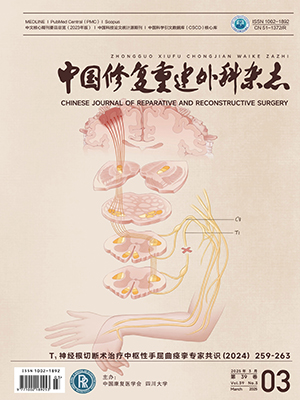Objective To compare the therapeutic effect of cannulated screws fixation at different time points through different reduction methods on the heal ing of displaced femoral neck fractures. Methods From January 1997 to September 2007, 240 patients with displaced femoral neck fracture were treated, including 121 males and 119 females aged 22-79 years old (average 56 years old). All cases were fresh and close fractures. According to the fractured part, there were 133
cases of subcapital fracture, 64 of transcervical fracture and 43 of basal fracture. According to Garden classification, there were 105 cases of type III and 135 of type IV. Cannulated screws fixation was performed on all the patients, and the time from injury to operation was 6 hours to 7 days. Fifty-five cases received closed reduction and 59 cases received l imited open reduction as emergency treatment, while 65 cases received closed reduction and 61 cases received l imited open reduction as selective operation. Different groups were compared in terms of the heal ing rate of fracture, the excellent and good rate of reduction as well as the excellent and good rate of fixation. Results There was no significant difference between the closed reduction and the l imited open reduction in terms of operation time and bleeding volume (P gt; 0.05). Postoperatively, all wounds healed by first intention, no infection was observed, avascular necrosis of femoral head occurred in 44 cases, and the rate of avascular necrosis of femoral head in the l imited open reduction at emergency group was less than that of other 3 groups (P lt; 0.01). All the patients were followed up for 12-72 months (average 38 months), 193 cases got fracture heal ing at 10-23 months after operation (average 14 months). For the closed reduction as emergency operation group, the l imited open reduction as emergency operation group, the closed reduction as selective operation group, and the l imited open reduction as selective operation group, the heal ing rate of fracture was 74.55%, 91.53%, 69.23% and 86.89%, respectively; the excellent and good rate of reduction was 73.73%, 94.92%,
70.77% and 91.80%, respectively; the excellent and good rate of fixation was 76.36%, 93.22%, 73.85% and 88.52%, respectively. The heal ing rate of fracture, the excellent and good rate of reduction as well as the excellent and good rate of fixation in the l imited open groups were higher than that of the closed reduction groups (P lt; 0.01), and there was no significant difference between the emergency operation groups and the selective operational groups (P gt; 0.05). Conclusion The reduction methods have significant influences on the heal ing of fractures after cannulated screws fixation of the displaced femoral neck fracture, and the operation time has no obvious effect on fracture heal ing.
Citation: TIAN Wei,CUI Zhuang,KAN Shilian. COMPARISON OF CANNULATED SCREWS FIXATION WITH DIFFERENT REDUCTION METHODS AT DIFFERENT TIME POINTS FOR DISPLACED FEMORAL NECK FRACTURES IN TERMS OF FRACTURE HEALING. Chinese Journal of Reparative and Reconstructive Surgery, 2009, 23(4): 440-443. doi: Copy
Copyright © the editorial department of Chinese Journal of Reparative and Reconstructive Surgery of West China Medical Publisher. All rights reserved




